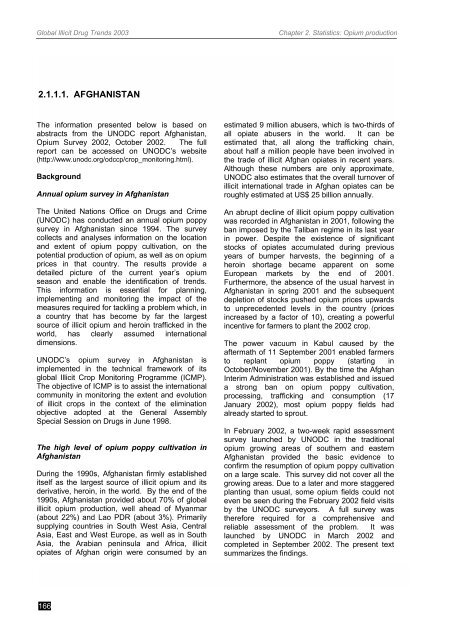global illicit drug trends 2003 - United Nations Office on Drugs and ...
global illicit drug trends 2003 - United Nations Office on Drugs and ...
global illicit drug trends 2003 - United Nations Office on Drugs and ...
You also want an ePaper? Increase the reach of your titles
YUMPU automatically turns print PDFs into web optimized ePapers that Google loves.
Global Illicit Drug Trends <str<strong>on</strong>g>2003</str<strong>on</strong>g><br />
Chapter 2. Statistics: Opium producti<strong>on</strong><br />
2.1.1.1. AFGHANISTAN<br />
The informati<strong>on</strong> presented below is based <strong>on</strong><br />
abstracts from the UNODC report Afghanistan,<br />
Opium Survey 2002, October 2002. The full<br />
report can be accessed <strong>on</strong> UNODC’s website<br />
(http://www.unodc.org/odccp/crop_m<strong>on</strong>itoring.html).<br />
Background<br />
Annual opium survey in Afghanistan<br />
The <str<strong>on</strong>g>United</str<strong>on</strong>g> <str<strong>on</strong>g>Nati<strong>on</strong>s</str<strong>on</strong>g> <str<strong>on</strong>g>Office</str<strong>on</strong>g> <strong>on</strong> <strong>Drugs</strong> <strong>and</strong> Crime<br />
(UNODC) has c<strong>on</strong>ducted an annual opium poppy<br />
survey in Afghanistan since 1994. The survey<br />
collects <strong>and</strong> analyses informati<strong>on</strong> <strong>on</strong> the locati<strong>on</strong><br />
<strong>and</strong> extent of opium poppy cultivati<strong>on</strong>, <strong>on</strong> the<br />
potential producti<strong>on</strong> of opium, as well as <strong>on</strong> opium<br />
prices in that country. The results provide a<br />
detailed picture of the current year’s opium<br />
seas<strong>on</strong> <strong>and</strong> enable the identificati<strong>on</strong> of <str<strong>on</strong>g>trends</str<strong>on</strong>g>.<br />
This informati<strong>on</strong> is essential for planning,<br />
implementing <strong>and</strong> m<strong>on</strong>itoring the impact of the<br />
measures required for tackling a problem which, in<br />
a country that has become by far the largest<br />
source of <str<strong>on</strong>g>illicit</str<strong>on</strong>g> opium <strong>and</strong> heroin trafficked in the<br />
world, has clearly assumed internati<strong>on</strong>al<br />
dimensi<strong>on</strong>s.<br />
UNODC’s opium survey in Afghanistan is<br />
implemented in the technical framework of its<br />
<str<strong>on</strong>g>global</str<strong>on</strong>g> Illicit Crop M<strong>on</strong>itoring Programme (ICMP).<br />
The objective of ICMP is to assist the internati<strong>on</strong>al<br />
community in m<strong>on</strong>itoring the extent <strong>and</strong> evoluti<strong>on</strong><br />
of <str<strong>on</strong>g>illicit</str<strong>on</strong>g> crops in the c<strong>on</strong>text of the eliminati<strong>on</strong><br />
objective adopted at the General Assembly<br />
Special Sessi<strong>on</strong> <strong>on</strong> <strong>Drugs</strong> in June 1998.<br />
The high level of opium poppy cultivati<strong>on</strong> in<br />
Afghanistan<br />
During the 1990s, Afghanistan firmly established<br />
itself as the largest source of <str<strong>on</strong>g>illicit</str<strong>on</strong>g> opium <strong>and</strong> its<br />
derivative, heroin, in the world. By the end of the<br />
1990s, Afghanistan provided about 70% of <str<strong>on</strong>g>global</str<strong>on</strong>g><br />
<str<strong>on</strong>g>illicit</str<strong>on</strong>g> opium producti<strong>on</strong>, well ahead of Myanmar<br />
(about 22%) <strong>and</strong> Lao PDR (about 3%). Primarily<br />
supplying countries in South West Asia, Central<br />
Asia, East <strong>and</strong> West Europe, as well as in South<br />
Asia, the Arabian peninsula <strong>and</strong> Africa, <str<strong>on</strong>g>illicit</str<strong>on</strong>g><br />
opiates of Afghan origin were c<strong>on</strong>sumed by an<br />
estimated 9 milli<strong>on</strong> abusers, which is two-thirds of<br />
all opiate abusers in the world. It can be<br />
estimated that, all al<strong>on</strong>g the trafficking chain,<br />
about half a milli<strong>on</strong> people have been involved in<br />
the trade of <str<strong>on</strong>g>illicit</str<strong>on</strong>g> Afghan opiates in recent years.<br />
Although these numbers are <strong>on</strong>ly approximate,<br />
UNODC also estimates that the overall turnover of<br />
<str<strong>on</strong>g>illicit</str<strong>on</strong>g> internati<strong>on</strong>al trade in Afghan opiates can be<br />
roughly estimated at US$ 25 billi<strong>on</strong> annually.<br />
An abrupt decline of <str<strong>on</strong>g>illicit</str<strong>on</strong>g> opium poppy cultivati<strong>on</strong><br />
was recorded in Afghanistan in 2001, following the<br />
ban imposed by the Taliban regime in its last year<br />
in power. Despite the existence of significant<br />
stocks of opiates accumulated during previous<br />
years of bumper harvests, the beginning of a<br />
heroin shortage became apparent <strong>on</strong> some<br />
European markets by the end of 2001.<br />
Furthermore, the absence of the usual harvest in<br />
Afghanistan in spring 2001 <strong>and</strong> the subsequent<br />
depleti<strong>on</strong> of stocks pushed opium prices upwards<br />
to unprecedented levels in the country (prices<br />
increased by a factor of 10), creating a powerful<br />
incentive for farmers to plant the 2002 crop.<br />
The power vacuum in Kabul caused by the<br />
aftermath of 11 September 2001 enabled farmers<br />
to replant opium poppy (starting in<br />
October/November 2001). By the time the Afghan<br />
Interim Administrati<strong>on</strong> was established <strong>and</strong> issued<br />
a str<strong>on</strong>g ban <strong>on</strong> opium poppy cultivati<strong>on</strong>,<br />
processing, trafficking <strong>and</strong> c<strong>on</strong>sumpti<strong>on</strong> (17<br />
January 2002), most opium poppy fields had<br />
already started to sprout.<br />
In February 2002, a two-week rapid assessment<br />
survey launched by UNODC in the traditi<strong>on</strong>al<br />
opium growing areas of southern <strong>and</strong> eastern<br />
Afghanistan provided the basic evidence to<br />
c<strong>on</strong>firm the resumpti<strong>on</strong> of opium poppy cultivati<strong>on</strong><br />
<strong>on</strong> a large scale. This survey did not cover all the<br />
growing areas. Due to a later <strong>and</strong> more staggered<br />
planting than usual, some opium fields could not<br />
even be seen during the February 2002 field visits<br />
by the UNODC surveyors. A full survey was<br />
therefore required for a comprehensive <strong>and</strong><br />
reliable assessment of the problem. It was<br />
launched by UNODC in March 2002 <strong>and</strong><br />
completed in September 2002. The present text<br />
summarizes the findings.<br />
166
















